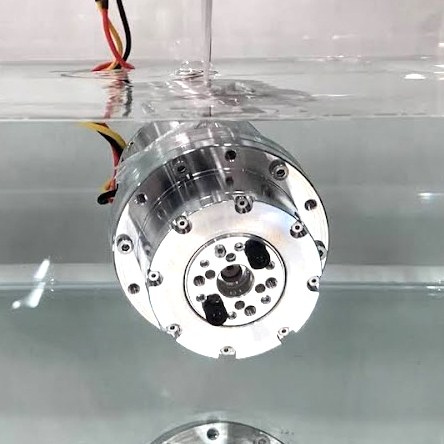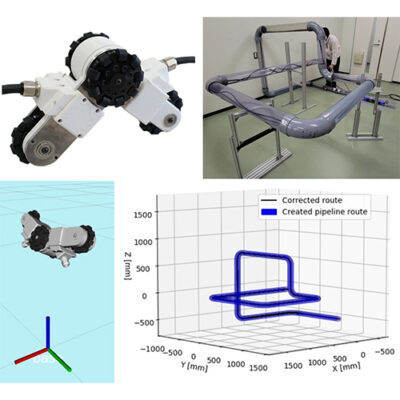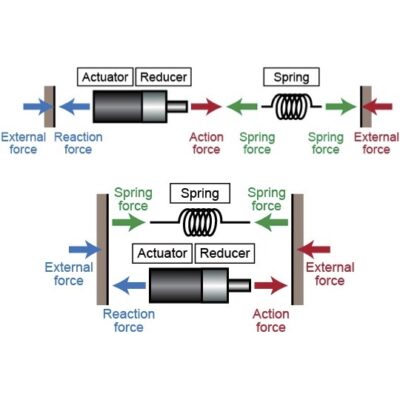In the history of robotics, attention has often focused on the use of elastic materials to reduce the energy consumption of robots and their actuators. A typical example is the series elastic actuator (SEA), which is also introduced here. On the other hand, parallel elastic actuators (PEA) are also often employed for robots. Both SEA and PEA are composed of a motor and an elastic body, but they are mounted in different ways: in PEA, the end points of the elastic body are fixed where the action and reaction of the motor are applied, and the internal force of the motor and the restoring force of the elastic body are arranged to interfere with each other. This parallel arrangement of a motor and an elastic body is often seen in “gravity compensation mechanisms”. However, most gravity compensation mechanisms use elastic bodies to compensate for the static force (gravity).

Metal coil springs are often used in general PEA. However, the joint structure tends to be complicated and large in order to provide space for the coil spring to expand and contract. In this study, we propose a plate-spring type parallel elastic actuator (Plate-Springed PEA, we named this as PSPEA) that uses only a single thin metal plate spring.
The elasticity values of coil springs are specified in catalogs. However, in the case of plate springs, only the type of metal, length and width, and thickness are specified, but not the specific elastic value. This is because the elastic value varies depending on where the plate spring is fixed. Therefore, in this study, a new stiffness model of a plate spring was constructed using a discrete model. When a force is applied to a spring, it generally settles into a shape that minimizes its elastic energy. This is a well-known phenomenon in nature, not limited to springs. Using this mechanism, the shape of a spring when the PEA’s motor is driven can be obtained, from which the stiffness can be derived.

In this study, the Rigid Body Spring Model (RBSM) method was used to derive the spring shape for an arbitrary joint angle, and the external force applied to the fixed end of the spring was derived from the shape. Once the external force and joint angle are known, the stiffness (external force torque/joint angle) can be calculated. From this analysis, it was revealed that the stiffness of the PEA spring is almost linear with the joint angle. Once the stiffness is known, designing a PEAed robot becomes easier.
※本成果は,ウォータールー大学Mechanical Systems & Control Laboratoryとの共同研究の結果,生まれたものです.また,科学研究費助成事業(若手研究)「板バネとDDモータによる周期運動のための高効率小型並列弾性アクチュエータの研究」19K14949の支援を受けました.
Related works
- Atsushi Kakogawa, Taihei Kawabata, and Shugen Ma, Plate-springed Parallel Elastic Actuator for Efficient Snake Robot Movement, IEEE/ASME Transactions on Mechatronics, Vol. 26, Iss. 6, pp. 3051-3063, 2021
- Atsushi Kakogawa, Taihei Kawabata, and Shugen Ma, Plate Springed Parallel Elastic Actuators for Efficient Movement of a Planar Snake Robot, Proceedings of the IEEE/ASME International Conference on Advanced Intelligent Mechatronics (AIM 2019), pp. 235-240, 2019
- 加古川篤,川端泰平,馬書根,並列弾性アクチュエータを用いたヘビ型ロボットの低速運動時におけるエネルギー消費抑制,システム制御情報学会論文誌,32巻,6号,pp. 227-233, 2019
- 加古川篤,馬書根,並列弾性アクチュエータを用いた高効率2次元ヘビ型ロボットの剛性設計,第62回システム制御情報学会研究発表講演会 (SCI’18),2018
- Atsushi Kakogawa, Soo Jeon, and Shugen Ma, Stiffness Design of a Resonance-based Planar Snake Robot with Parallel Elastic Actuators, IEEE Robotics and Automation Letters (RA-L), Vol. 3, Iss. 2, pp. 1284-1291, 2018
Previous studies that served as references for this study
- S. Hirose, Biologically Inspired Robots, London, U.K.: Oxford University Press, 1993
- D. W. Robinson, J. E. Pratt, D. J. Paluska and G. A. Pratt, Series elastic actuator development for a biomimetic walking robot, Proc. IEEE/ASME Int. Conf. Adv. Intell. Mechatron., pp. 561-568, Sep. 1999
- J. Hurst and A. Rizzi, Series compliance for an efficient running gait, IEEE Robot. Autom. Mag., vol. 15, no. 3, pp. 42-51, Sep. 2008
- M. Uemura, K. Kanaoka, and S. Kawamura, A new control method utilizing stiffness adjustment of mechanical elastic elements for serial link systems, Proc. IEEE Int. Conf. Robot. Autom., pp. 1437–1442, 2007
- M. Uemura and S. Kawamura, Resonance-based motion control method for multi-joint robot through combining stiffness adaptation and iterative learning control, Proc. IEEE Int. Conf. Robot. Autom., pp. 1543-1548, 2009
- M. Uemura,, H. Goya and S. Kawamura, Motion control with stiffness adaptation for torque minimization in multijoint robots, IEEE Trans. Robot., vol. 30, no. 2, pp. 352-364, 2014
- K. Ono, T. Furuichi and and R. Takahashi, Self-excited walking of a biped mechanism with feet, Int., J. Robot. Res., vol. 20, no. 12, pp. 953-966, 2001
- J. Ute and K. Ono, Fast and efficient locomotion of a snake robot based on self-excitation principle, Proc. 7th Int. Workshop Adv. Motion Control, pp. 532–539, 2002
- D. Efimov, A. Fradkov and and T. Iwasaki, On finite time resonance entrainment in multi-DOF systems, Proc. Amer. Control Conf., pp. 1035-1039, 2012




